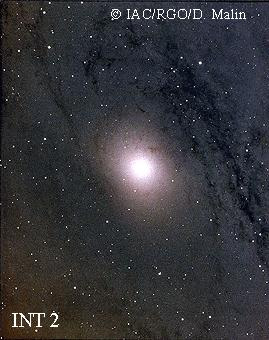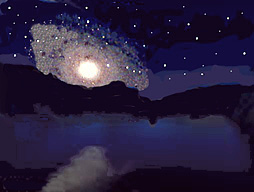Andromeda Galaxy, the "Little Cloud"

The above image of M31, the Andromeda Galaxy, is of the central
core and covers about a third of its actual size. To give you an
idea of how large this object is, 6 full moons stacked end to end
would be about equal to its diameter!
This image is the result of a six hour processing marathon in
Photoshop (an amazing program) with the goal of squeezing
as much detail as possible out of the meager image I was
able to obtain with my 8" SCT telescope and modified webcam.
Here's one raw frame before any processing was done:

If you take a close look at the raw image (that's it - get your nose
right up close to the screen), you can see some of the detail
around the core just ever so faintly visible.
To determine if the detail seen, particularly around the bright central
core is real and not processing artifacts, I scoured the internet for
another image of M31 which shows at least some detail around
the edge of the core itself and this is what I found:

This is an image obtained with the Isaac Newton Telescope by David
Malin: Isaac Newton Telescope
As you can see, there are two objects, one at 1 o'clock and one
at 6 o'clock which indicate that the detail around the core is in fact
real. My image is tilted from this one so the objects are at 12 o'clock
and 5 o'clock. Looking closer, you can see that there are two additional confirmation objects at the 12 o'clock position.
Andromeda is about twice as big as the Milky way with about
twice the number of stars and is the largest of our local group
of 30 galaxies. It is 2.2 million light years away, 125,000
light years in diameter and has a central black hole the size
of 30 million suns.
M31 is one galaxy you'll never have to wonder if we will ever visit
because it's on its way to visit us! It's headed our way at about
68 kilometers per second and in all likelihood will meet us in
a head on collision. Even if Earth happens to be on that side
of the galaxy when it happens, I wouldn't worry too much. The
collision, for our planet, probably won't be too cataclysmic because
,even though galaxies contain many billions of stars, they are
mostly "empty" space and the chance of any given two stars
meeting is quite small. However,galactic collisions can cause drastic
effects on the basic shapes of galaxies. wreak havoc on gas
and dust formations and trigger a large number of new star
formations.
With Andromeda's rapid movement towards us, perhaps a million or
so years from now a stargazer on planet Earth will be treated
to a nightsky view similar to this:

'Andromeda Rise' by Rick Murray
Notes: Up to now only one supernova has been recorded in the
Andromeda Galaxy, called Supernova 1885, which was discovered
by Ernst Hartwig (1851-1923) on August 20, 1885 and was also
the first supernova discovered beyond our Milky Way.
The first known representation of the Andromeda Nebula, as it was
first known, marked with the letter 'A' by Persian astronomer Abd-
Al-Rahman Al Sufi in his 'Book of Fixed Stars' of 964 AD. He called
it the "Little Cloud":

Techno Stuff: 40.5 sec X 48, 24 frames processed, 8" SCT,
Mogg 0.6 fr, Mogg extender for FL 3.3, Baader IR Filter, Toucam
840k SC1.5, Normal Mode, 5 FPS, Brightness 40%, Gamma 25%,
Saturation 45%, White Balance Auto, Gain 75%, Altitude 78 deg.
Polar Mode
In order to get this level of detail, I used a Photoshop gaussian
blur and unsharp masking cycle about four times and was amazed
to see the details literally 'pop out' on the fourth pass.


